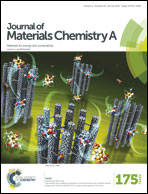High performance NiO nanosheets anchored on three-dimensional nitrogen-doped carbon nanotubes as a binder-free anode for lithium ion batteries†
Abstract
Transition metal oxides (TMOs) have attracted extensive research attention as promising anode materials for lithium ion batteries due to their high theoretical capacities. However, their applications have been hindered by their poor electronic conductivity and drastic volume change in the reversible conversion reaction. Here three-dimensional NiO ultrathin nanosheets were grown on the composites of N-doped carbon nanotubes (N-CNTs) and Ni foam by chemical vapor deposition and electrochemical deposition methods, and the 3D Ni foam/N-CNT/NiO nanosheet electrode thus obtained exhibits larger capacity, better cycling stability, superior rate capability and higher ionic conductivity. The first-principles calculations suggest that N-doping can improve the interaction between NiO and N-CNTs, which can facilitate fast electron hopping from N-CNTs to NiO to enhance the electronic conductivity. The results indicate that the introduction of N-doped carbon nanotubes can greatly improve the electrochemical performance of NiO. The understanding between N-CNTs and NiO can be extended to the preparation of N-CNTs coated with other high-performance electrode materials for energy-storage devices.


 Please wait while we load your content...
Please wait while we load your content...